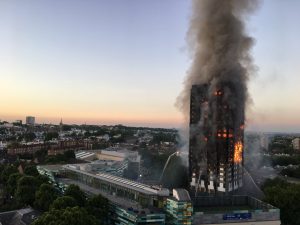In the night of 14 June 2017, a fire started in a skyscraper in the west of London. 72 people died in the Grenfell Tower fire. It was the worst fire catastrophe in Great Britain for decades and the catastrophe could probably have been avoided.

Lancaster West Estate residents organised themselves into the Grenfell Action Group in 2010 and, since 2012, when they were involved in planning the refurbishment of the Grenfell Tower, have regularly contacted the non-profit property management to draw attention to grievances.
In 2013, they published parts of a report prepared in the previous year that revealed significant violations of fire safety regulations. For example, parts of the fire-fighting equipment had not been serviced for three years. They documented their efforts in a blog.
It is absolutely incomprehensible that during the renovation of the skyscraper, the outer wall of which had previously been made of concrete, combustible materials could be used without an independent authority questioning or controlling this. To this day, the companies concerned say they were not to blame; after all, the administration and management knew what they were buying and ordering – insulation and cladding materials that were easily combustible.
During the renovation, Reynobond composite panels were used, which the manufacturer describes as “consisting of two stove-enamelled aluminium sheets”, “which are fused on both sides to a polyethylene core. Polyethylene has a melting point of 130 to 145 °C. The sheet, which can be produced inexpensively, is comparable to Dibond sheets in terms of layering and also achieves fire protection class B2 “normally flammable”.
It has been assumed so far that this design was installed on the high-rise building. There are two further versions of the panel with other core materials which achieve higher fire protection classes B-s1, d0 (“hardly inflammable”) and A2-s1, d0 (“non-combustible”) according to EN-13501.
However, these were probably not used for cost reasons.
A horrible example of a corporate culture in which profit takes precedence over safety.
